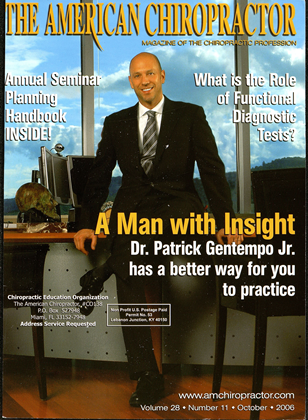SOME CONFUSION EXISTS REGARDING THE STATE OF THE IMMUNE system in patients that enter a chiropractic office. It is commonly held that immune systems are weak and the adjustment will increase the strength of the immune system. In fact, this oversimplification is generally incorrect. Weak immune systems lead to the opportunistic infections, as in the case of AIDS and organ transplant. Certain aspects of tumor establishment are associated with immune underac-tivity; however, other aspects of cancer development involve an overactive immune system. Most diseases from which we suffer are actually associated with immune over-activity, such as frank autoimmune problems like type I diabetes, rheumatoid arthritis, and multiple sclerosis.1- Although not typically considered classic autoimmune diseases, many common conditions are associated with overactive immune systems, such as osteoarthritis, atherosclerosis, inflammatory bowel disease, allergies, asthma, psoriasis, eczema and many other conditions.1'5 Even cold and flu symptoms, whether caused by a virus or physical injury, are known to be due to an overactive immune system, not one that is depressed.6 Vitamin D In recent years, there has been an explosion in vitamin D research. One of the best review articles was recently written by Alex Vasquez, DC, and his colleagues, which outlined the numerous conditions thought to be promoted by vitamin D deficiency.7 Germane to the topic of this column is that vitamin D may be the key substance that controls autoimmune expression.3 For simplicity, our T-cell population is typically divided into CD8+ cytotoxic T cells, and CD4+ helper T cells. The CD8, CD4 and other CD#s, refer to surface proteins found on lymphocytes. We are going to focus herein on CD4+ cells referred to as T-helper cells. T-helper cells are essentially in charge of modulating au-toimmunity. As T-helpcrs mature, they can develop into one of three different types of T-helper cells, including T-helper 1 (Thl), T-helper 2 (Th2),'and T-reguIatory (T-regs) cells. Thl cells release pro-inflammatory cytokines that lead to tissue damage associated with autoimmunity. Th2 cells release anti-inflammatory cytokines that balance Thl activity, so that an appropriate immune response can occur. T-regs are responsible for maintaining self-tolerance, so that our immune system does not react against the body and drive an autoimmune condition.' Researchers have recently determined that, with inadequate levels of vitamin D, there is an over-expression of Thl cells and an under-expression of Th2 cells and T-regs.' Indeed, in vivo studies in the laboratory have demonstrated that vitamin D therapy leads to a reduction in the autoimmune Th 1 response and a reduction of symptoms of experimental inflammatory bowel disease, rheumatoid arthritis, type 1 diabetes, and multiple sclerosis.' In a recent review by Grant and Holick,s they presented a chart of serum vitamin D levels [25(OH)D] for subjects in Florida, Massachusetts, Nebraska. Oregon, Calgary, Toronto, and Paris, France. Subjects in all locations maintained insufficient vitamin D levels throughout the year, and this is likely because of avoiding the sun. Humans are supposed to derive their vitamin D from sun exposure; there is virtually no vitamin D in natural diets. Recommendations for sun exposure are reviewed by Grant and Holick.*1 In general, the average person will generate adequate vitamin D levels if they expose their face, arms, and legs to the sun (10 A.M.-3 P.M. during spring, summer and fall) for about fifteen to thirty minutes per day. In the absence of adequate sun exposure, it is conservatively recommended that we supplement with about 1000 IU's of vitamin D3 (cholecalciferol) per day.' I, personally, take a multivitamin/mineral and when I am not getting adequate sun exposure. I supplement with an additional 1000-4000 IU of cholecalciferol per day. Summary Vitamin D has only recently been considered as vital for other bodily processes beyond bone health. Vitamin D may be a key factor in stabilizing our immune function. Eating an anti-inflammatory diet, also supplementing with a multi, fish oil, and ginger/tumeric seems to be the most prudent way to reduce the pro-inflammatory state that drives so many diseases.'1 References 1. Haddad PS et al. Natural products, modulation of immune function and prevention of chronic diseases. Evict Based Comp All Mecl. 2005;2(4):513-20 2. Kumar el al. Rohhins and Colran Pathologic Basis of Disease. 7th cd. New York: Elsevier;2005:p.223 3. Cantorna MT, Mahon BD. Mounting evidence for vitamin D as an environmental factor affecting autoimmune disease prevalence. Exp Biol Mecl. 2004; 229:1136-42 4. Nishioka K. Autoimmune response in cartilage-derived peptides in a patient with osteoarthritis. Arth Res They. 2003; 6:6-7 5. Uansson GK. Immune mechanisms in atherosclerosis. Arterioscler Thromb Vase Biol. 2001; 21:1876-90 6. Maier SF, Watkins LR. Cytokincs for psychologists: implications of bidirectional iinmune-to-brain communication for understanding behavior, mood, and cognition. Psychol Rev. 1998; 1O5(1):83-1O 7. Vasqucz A, Manso G, Cannell J. The clinical importance of vitamin D (cliolecalcif-erol): a paradigm shift with implications for all healthcare providers. Ahem Ther Health Mecl. 2004 Sep-Oct;10(5):28-36 8. Grant WB, Holick MF. Benefits and requirements of vitamin D for optimal health: a review. Alt Med Rev. 2005; 10:94-111 9. Seaman DR. Nutritional considerations for pain and inflammation. In Licbenson CL. Ed. Rehabilitation of the Spine: a Practitioner's Manual. Baltimore: Williams & Wilkins; 2006: p.728-740 Dr. Seaman is the Clinical Chiropractic Consultant for Anabolic Laboratories, one of the first supplement manufacturers to service the chiropractic profession. He is on the postgraduate faculties oj several chiropractic colleges, providing nutrition seminars that focus on the needs of the chiropractic patient. He is also a faculty member at Palmer College of Chiropractic Florida, where he teaches nutrition and subliixation theories. He can be reached by e-mail at docseaman(w,mac. com. I Humans are supposed to derive their vitamin D from sun exposure; there is virtually no vitamin D in natural diets.
 View Full Issue
View Full Issue






